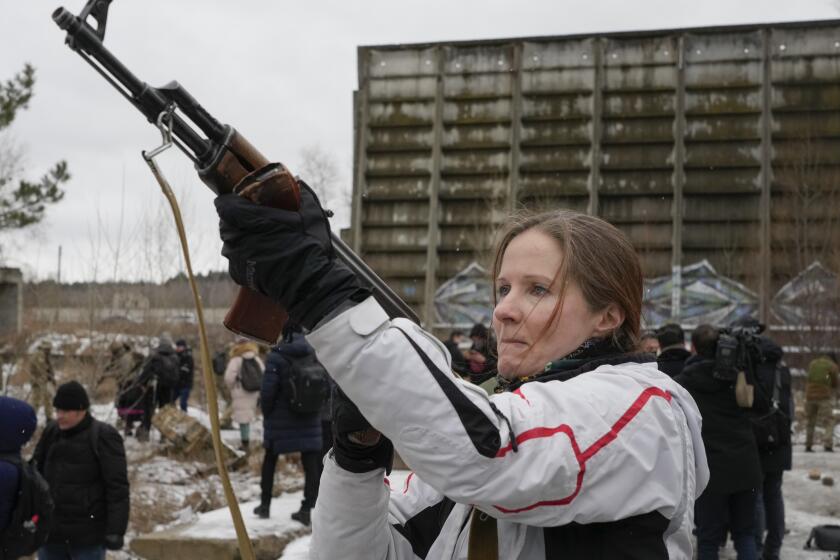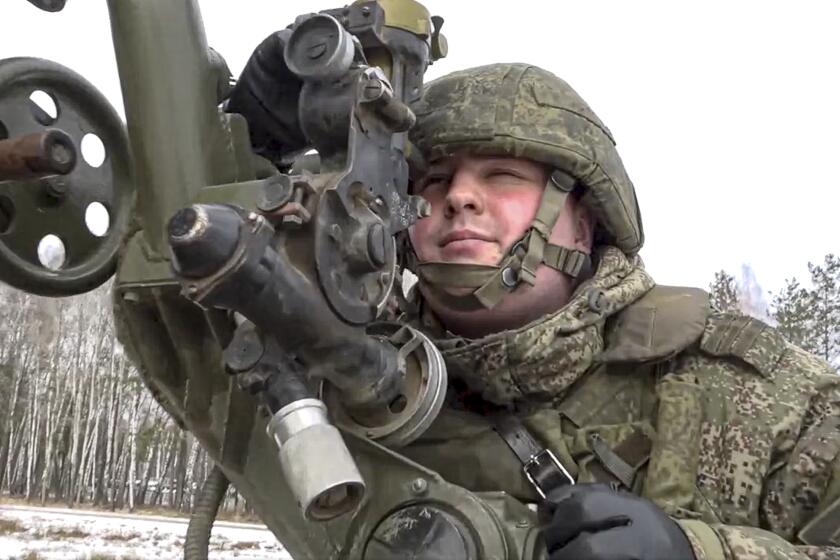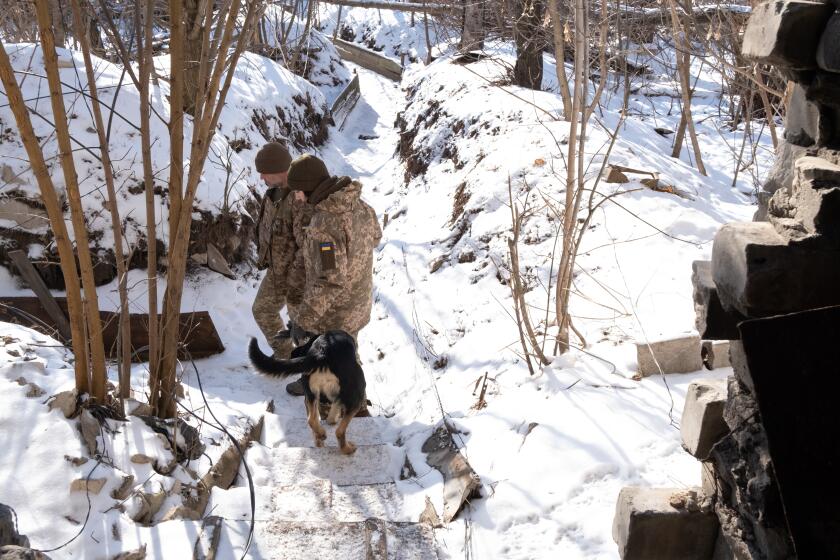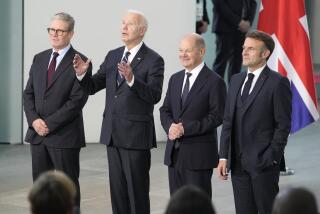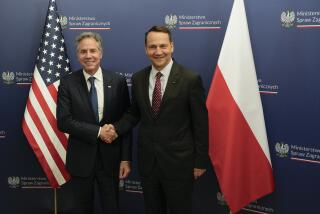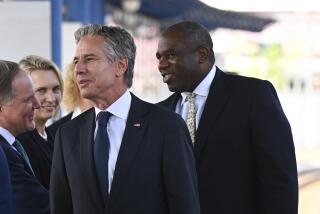Did flurry of talks amplify or soften drumbeat to war in Ukraine? What you need to know
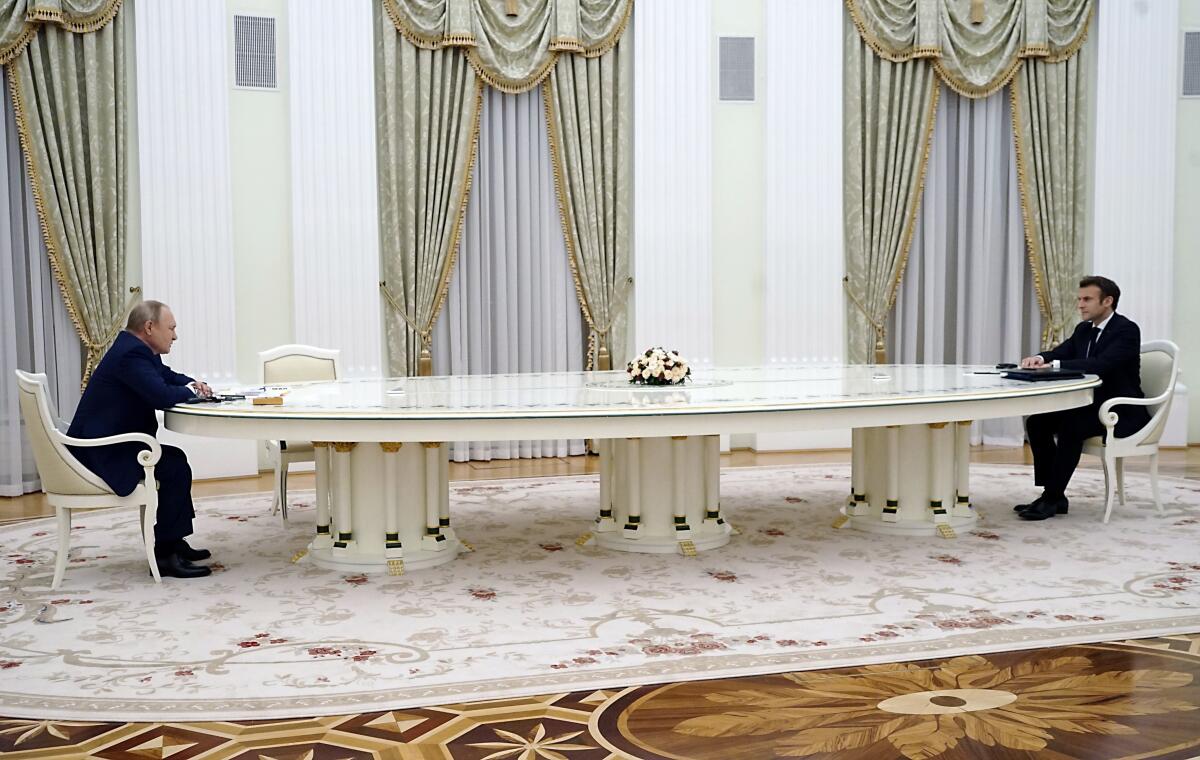
- Share via
BRUSSELS — Several world leaders lined up Monday to walk a diplomatic tightrope that could mean the difference between war in Ukraine and an uneasy peace there as Russia’s menacing actions along the border with its neighbor continued unabated.
Here’s a look at the latest developments in the crisis:
From Moscow to Washington
Russian President Vladimir Putin was back in Moscow on Monday following his diplomatic foray to get support from China over the weekend during the Winter Olympics. Putin hosted his French counterpart, Emmanuel Macron, who traveled to the Kremlin to try to de-escalate tensions.
President Biden and German Chancellor Olaf Scholz met at the White House to shore up Western resolve against what they see as Russian aggression against Ukraine. Biden explicitly singled out the pipeline project known as Nord Stream 2, which would bring additional Russian gas to Europe and could be certified by Germany to operate this summer. “There will no longer be Nord Stream 2” if Russia further invades Ukraine, Biden said. Scholz didn’t mention the pipeline but said Germany and the U.S. were “absolutely united” in their intention to impose punishing sanctions on Russia if it invades Ukraine.
U.S. Secretary of State Antony J. Blinken and European Union foreign policy chief Josep Borrell earlier said the United States and Europe remained unified on not only the nature of the Russian threat to Ukraine but the consequences that Russia would face if it invaded. They also defended the increasingly dire warnings that a Russian invasion may be imminent.
Plenty of residents of Kyiv don’t seem to think their capital is on borrowed time, but some are girding for a potential Russian invasion anyway.
Western estimates that more than 100,000 Russian troops have massed near Ukraine are increasing worries that an offensive could be only days away.
At the same time, borders of NATO nations that are close to Russia are also being shored up. Germany, which is often accused of being too lackadaisical toward Moscow, and Britain added to that effort on Monday and NATO itself also has plans.
France and Russia disagree, but more talks to come
Russian President Vladimir Putin and French President Emmanuel Macron wrapped up more than five hours of talks by registering their disagreements but also emphasizing the need for more talks.
Putin noted that the U.S. and NATO have ignored Moscow’s demands that NATO keep Ukraine and other ex-Soviet nations out, refrain from placing weapons there and roll back alliance forces from Eastern Europe. He nevertheless signaled his readiness to continue the negotiations.
Putin scoffed at Western descriptions of NATO as a defensive alliance, saying sarcastically that the “people of Iraq, Libya and Afghanistan have learned it from their own experience.”
He warned that Ukraine’s accession to NATO could trigger a war between Russia and the alliance.
“If Ukraine becomes a NATO member and moves to reclaim Crimea, European countries will automatically be drawn into a military conflict with Russia,” Putin said. “You will be drawn into that conflict beyond your will. There will be no winners.”
U.S. officials say Russia has assembled at least 70% of the military firepower it likely intends to have in place by mid-month to give Russian President Vladimir Putin the option of launching a full-scale invasion of Ukraine.
Macron said he had a “substantial, deep” discussion with Putin, with a focus on conditions that could help de-escalation.
“We tried to build converging elements,” he said. “The upcoming days will be crucial, and deep discussions together will be needed.”
He added that it was Europe’s duty to find a solution to try to rebuild neighborly ties with Russia.
After French move, Germany steps up
France and Germany have worked in tandem before. Seven years ago, they were essential in creating a peace deal for eastern Ukraine in a bid to end fighting between Ukrainian government forces and Russia-backed separatists that erupted in 2014 following the Russian annexation of Ukraine’s Crimean peninsula.
Ukrainian officials have called that peace deal unworkable and divisive, but it did tamp down the fighting.
Germany has been criticized for being slow and halfhearted in its approach to the Ukraine crisis, but on Monday, Europe’s economic powerhouse moved on different fronts. As Scholz got ready for his meeting with Biden, German Foreign Minister Annalena Baerbock had meetings in Kyiv with Ukrainian Prime Minister Denys Shmyhal and was set Tuesday to visit the “line of contact” with pro-Russia separatists in eastern Ukraine.
Slog of trench warfare in eastern Ukraine yields scenes reminiscent of World War I.
Germany’s show of solidarity comes amid tensions over Berlin’s refusal to send weapons to Ukraine. But Baerbock said that “we stand — without ifs or buts — by the territorial integrity of the country and at the side of the people in Ukraine.”
Baerbock added that “together, we will react with hard and very concrete measures to any further Russian aggression against Ukraine.”
To show that the Franco-German diplomatic effort is far from over, Scholz will meet Macron and Polish President Andrzej Duda to discuss the Ukraine crisis Tuesday. That will allow the three leaders to compare notes after Scholz’s meeting with Biden and Macron’s trips to Russia and Ukraine.
More troops bolster NATO’s eastern front
Britain says it is sending 350 troops to Poland as part of efforts to bolster NATO forces in Eastern Europe amid a Russian military buildup near Ukraine. British Defense Secretary Ben Wallace says the troops will join 100 Royal Engineers already in Poland.
Germany decided to send more troops to Lithuania, further reinforcing its presence on NATO’s eastern flank, in a move that comes amid criticism of Berlin’s refusal to send weapons to Kyiv. Defense Minister Christine Lambrecht said she would add up to 350 German troops to a NATO battle group it leads in the Baltic nation, where it already has some 500 soldiers.
Lambrecht said that, with the move, Germany was “sending a very clear signal of unity to our allies. We can be relied on and we are showing that with this strengthening of the battle group.”
Scholz on Thursday will host the leaders of Lithuania, Latvia and Estonia, the three Baltic states that feel the heat from Moscow, before traveling to Ukraine and Russia next week.
Breaking News
Get breaking news, investigations, analysis and more signature journalism from the Los Angeles Times in your inbox.
You may occasionally receive promotional content from the Los Angeles Times.
NATO Secretary-General Jens Stoltenberg also said the alliance was weighing a more permanent military presence in southeast Europe.
“We are considering more longer-term adjustments to our posture, our presence in the eastern part of the alliance,” Stoltenberg told reporters after talks with Poland’s Duda. “If Russia really wants less NATO close to the borders, they get the opposite.”
How is Europe going to find more gas?
When it comes to feeling the heat during winter, Europe is particularly dependent on Russia’s energy supplies. The EU is also complaining that Moscow has not been forthcoming with additional gas shipments to Europe when market logic, with its current sky-high prices, would make it a no-brainer.
More than 40% of Europe’s gas supplies come from Russia. Borrell, the EU foreign policy chief, said on the eve of an EU-U.S. energy meeting in Washington on Monday that “Russia has already in the past used energy supplies for political purposes.” Now, the 27-nation bloc desperately needs to diversify its gas sources and is finding a helping hand in Washington.
“The United States will do everything we can to help ease any disruptions to Europe’s energy supply, and indeed, we already are,” Blinken said, adding that Washington is in talks with major producers and nations around the world.
More to Read
Sign up for Essential California
The most important California stories and recommendations in your inbox every morning.
You may occasionally receive promotional content from the Los Angeles Times.
